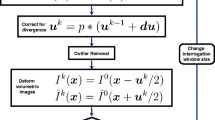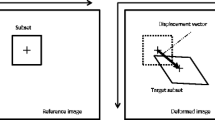Abstract
Digital volume correlation is a new experimental technique that allows the measurement of the full-field strain tensor in three dimensions. We describe the addition of rotational degrees of freedom into the minimization problem for digital volume correlation in order to improve the overall performance of the strain measurement. A parameterization of rotations that is particularly suited to the minimization problem is presented, based on the angle-axis representation of finite rotations. The partial derivative of both a normalized cross-correlation coefficient and the sum-of-squares correlation coefficient are derived for use with gradient-based minimization algorithms. The addition of rotation is shown to greatly reduce the measurement error when even small amounts of rigid body rotation are present in an artificially rotated test volume. In an aluminum foam sample loaded in compression, including rotational degrees of freedom produced smoother contours of minimum principal strain. Renderings of the aluminum foam architecture in areas of low, medium and high rotation showed material deformation pattern in detail.
Similar content being viewed by others
References
Knauss, Wolfgang G., “Perspectives in Experimental Solid Mechanics,”Int. J. Solids and Structures,37,251–266 (2000).
Feldkamp, L.A., Goldstein, S.A., Parfitt, A.M., Jesion, G., andKleerekoper, M., “The Direct Examination of Three-dimensional Bone Architecture in Vitro By Computed Tomography,”J. Bone and Mineral Research,4 (1),3–10 (1989).
Müller, R., Koller, B., Hildebrand, T., Laib, A., Gianolini, S., andRüegsegger, P., “Resolution Dependency of Microstructural Properties of Cancellous Bone Based on Three-dimensional μ-tomography,”Technology and Health Care,4,113–119 (1996).
Odgaard, A., “Three-dimensional Methods for the Quantification of Cancellous Bone Architecture,” Bone,20 (4),315–328 (1997).
Bay, Brian K., Smith, Tait S., Fyhrie, David P., andSaad, Malik, “Digital Volume Correlation: Three-dimensional Strain Mapping Using X-ray Tomography,” EXPERIMENTAL MECHANICS,39 (3),217–226 (1999).
Sutton, M.A., McNeill, S.R., Jang, J., andBabai, M., “Effects of Subpixel Image Restoration on Digital Correlation Error Estimates,”Optical Engineering,27 (10),870–877 (1988).
Chu, T.C., Ranson, W.F., Sutton, M.A., andPeters, W.H., “Applications of Digital-image-correlation Techniques to Experimental Mechanics,” EXPERIMENTAL MECHANICS,25 (3),232–244 (1985).
Bruck, H.A., McNeill, S.R., Sutton, M.A., andPeters, W.H., “Digital Image Correlation Using Newton-raphson Method of Partial Differential Correction,” EXPERIMENTAL MECHANICS,29 (3),261–267 (1989).
Fu, K.S., Gonzalez, R.C., andLee, C.S.G., Robotics: Control, Sensing, Vision, and Intelligence, McGraw-Hill, New York (1987).
Gonzalez, Rafael C. andWoods, Richard E., Digital Image Processing, Addison-Wesley, Reading, MA (1992).
Gill, Philip E., Murray, Walter, andWright, Margaret H., Practical Optimization, Academic Press, San Diego, CA (1981).
Gordon, William J., Blending-function Methods of Bivariate and Multivariate Interpolation and Approximation, SIAM J. Numerical Analysis,8 (1),158–177 (1971).
Lancaster, Peter andŠalkauskas, Kęstutis, Curve and Surface Fitting—An Introduction, Academic Press, San Deigo, CA (1986).
Geers, M.G.D., de Borst, R., andBrekelmans, W.A.M., “Computing Strain Fields from Discrete Displacement Fields in 2D-solids,”Int. J. Solids and Structures,33 (29),4293–4307 (1996).
Zhu, Y., Drangova, M., andPelc, N.J., “Estimation of Deformation Gradient and Strain from Cine-PC Velocity Data,”IEEE Transactions on Medical Imaging,16 (6),840–851 (1997).
Reimann, D.A., Hames, S.M., Flynn, M.J., andFyhrie, D.P., “A Cone Beam Computed Tomography System for True 3D Imaging of Specimens,”Applied Radiation and Isotopes,48 (10),1433–1436 (1997).
Author information
Authors and Affiliations
Rights and permissions
About this article
Cite this article
Smith, T.S., Bay, B.K. & Rashid, M.M. Digital volume correlation including rotational degrees of freedom during minimization. Experimental Mechanics 42, 272–278 (2002). https://doi.org/10.1007/BF02410982
Received:
Accepted:
Issue Date:
DOI: https://doi.org/10.1007/BF02410982




